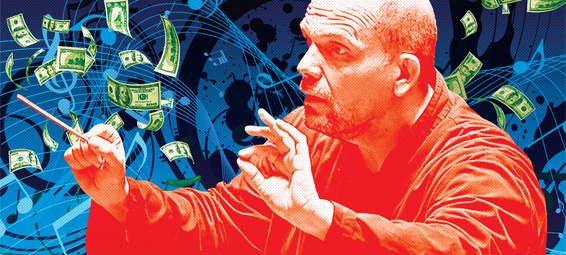This article appears in the January edition of D Magazine.
On a Tuesday in early November, Dallas Symphony Orchestra board chairman Blaine Nelson gathered a small group of upper-tier symphony donors to tell them the bad news: the DSO was running out of cash—fast. In fact, Nelson said, if the symphony didn’t find cash by the end of January, it would hit the $8 million limit on the line of credit it has been using to keep the doors open.
That the symphony is in dire straights has been well documented. It has been running operating deficits ever since the 2008–2009 season. Its endowment plummeted from $120 million to $84 million after the economic downturn, though the fund’s balance was back up to $96.8 million as of May 2011. Then there were the administrative troubles, which have left the symphony effectively without a CEO since the departure of Doug Adams in August 2010. Bill Lively, who led the North Texas Super Bowl Host Committee, took the helm in April 2011, only to resign one month later.
To counterbalance the recent financial trouble, the DSO released a “new business plan” after Nelson’s donor meeting. The prescription for the symphony includes cutting the number of classical subscription series concerts by five, while maintaining the number of performances featuring the symphony’s two superstar conductors, Jaap van Zweden and pops musical director Marvin Hamlisch. The symphony also plans to play more community concerts and invest in its educational programming.
Reading between the lines, you can see how the symphony is repositioning itself. A typical concert will see the hall filled to about 65 percent of capacity with paying attendees (its current average). Decreasing the number of performances will, the symphony hopes, increase the paying customers at each performance.
And more concerts in the communities and in front of schoolchildren will—also, hopefully—cultivate future audiences. The DSO is trying to address dwindling interest.
Pianist and writer Charles Rosen once said that “the death of classical music is perhaps its oldest continuing tradition.” But right now, the classical music world is in the midst of frightfully tough times. Musician union strikes have plagued dozens of orchestras around the country, and there is the renewed fear that the audience for live classical music is changing. A 2011 report by the National Endowment for the Arts shows that younger people are attending fewer arts events just as older people are slowing down and also attending fewer events.
Douglas Dempster, dean of the College of Fine Arts at the University of Texas, wrote a paper during the last recession, in the early 2000s, largely dismissing claims that the audience for classical music is dying out. But today he says the problem isn’t with the interest in classical music, but with interest in attending live performances in general. What we may be experiencing, Dempster says, is not just the typical troubles that follow in the wake of tough economic times, but economic forces that are beginning to strain the very system that has supported modern day orchestras.
“On the one hand, whenever we have a recession, people cry Chicken Little,” Dempster says. “But that doesn’t mean that there aren’t bigger economic cycles, like climate cycles, and at a certain point you hit a breaking point. This could be a historical process playing out over 100 years.”
Tim Page, a Pulitzer Prize-winning music critic who teaches at the University of Southern California, says he thinks the classical music industry has hit that breaking point and that only the top-tier orchestras—Cleveland,Boston,Chicago,New York—will survive.
“I look at the future of the big orchestras, and without financial angels, it is very grim,” Page says. “We hear music so easily for free, and it is so expensive to get 100 people together [to play it]. I don’t know many people my age who have subscriptions, but my grandmother did.”
A few orchestras have found a way to make it into the black in recent years. The Los Angeles Philharmonic has ridden the popularity of its own energetic celebrity conductor, Gustavo Dudamel, but unlike Dallas, it also has the help of a new Frank Gehry-designed spectacle of a symphony center. The New World Symphony in Miami has enjoyed critical success while cutting costs by hiring young musicians to fill its ranks, thus making it something of a musicians’ training ground.
Hiring young musicians is one way to cut costs, Dempster says, but the strategy runs the risk of creating problems similar to those now faced by higher education and health care. “Back in the 1960s, there was a study done by two economists that said that the performing arts could not sustain itself without public subsidies because the cost of talent would always go up faster than the background rate of inflation,” Dempster says. “That is not different than what higher education and health care have experienced. They are the exact same economic principals. The model is broken. They have been surviving, but there is no reason to assume that that is boundless.”
For now, the Dallas Symphony Orchestra is doing what it can, focusing the artistic attention on concerts driven by the talent and personality of its hot conductor in an effort to generate more revenue per performance. It will also invest heavily in building audiences. Whether these community investments will one day create new ticket buyers is yet to be seen. In the short term, the real question remains, as ever: how long can Dallas’ financial angels afford to keep the music playing?





